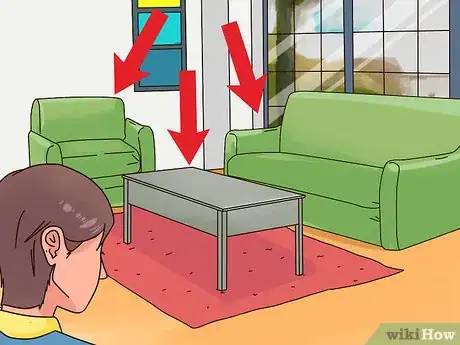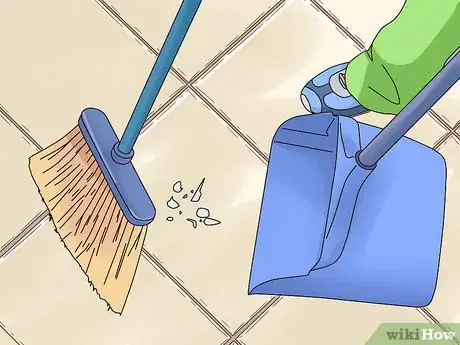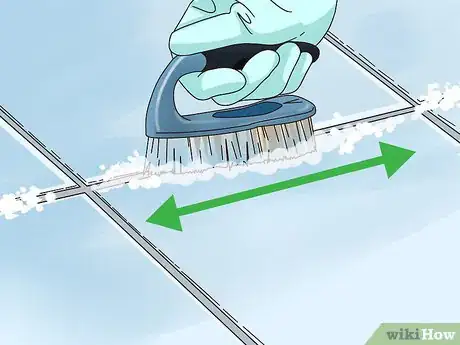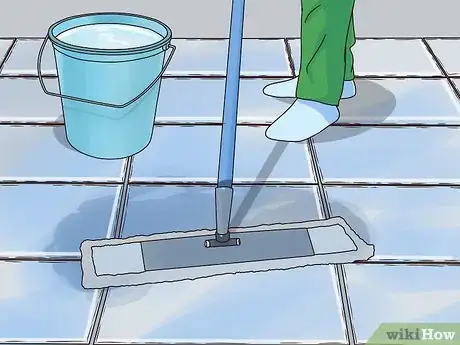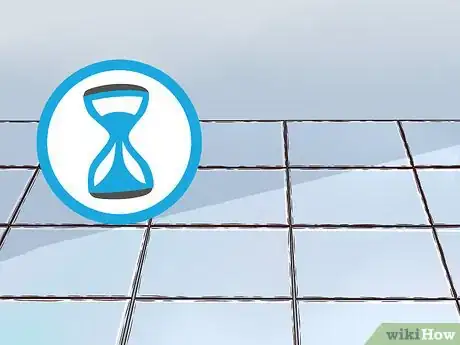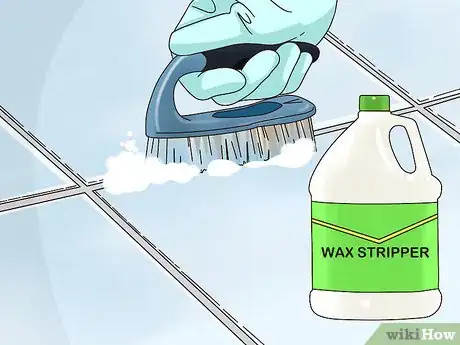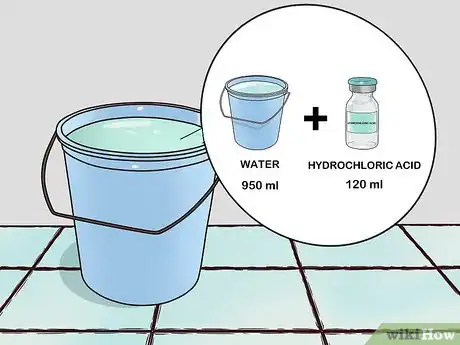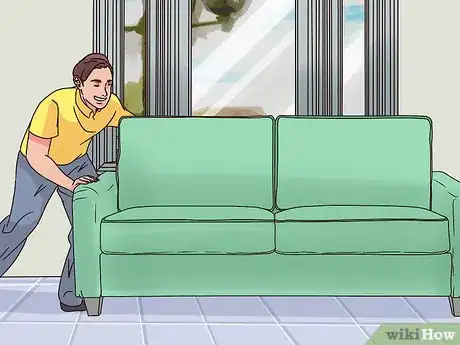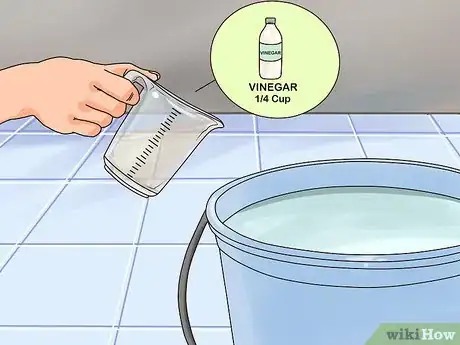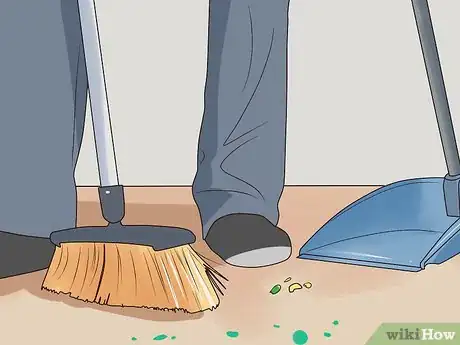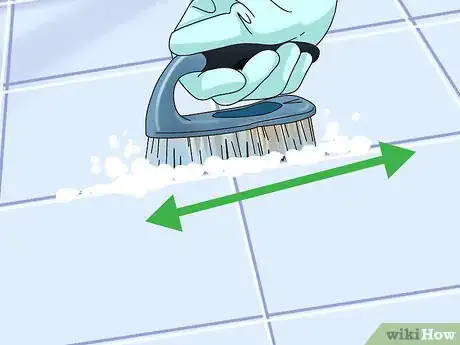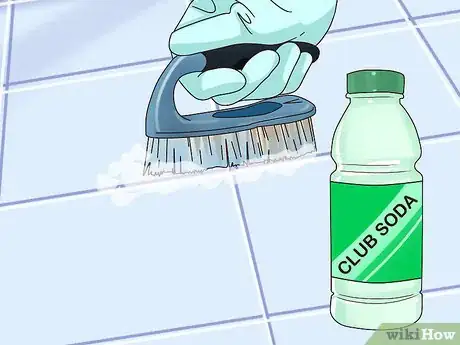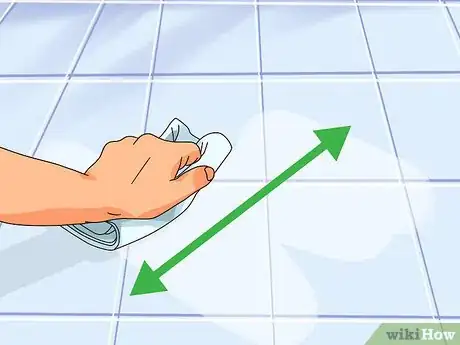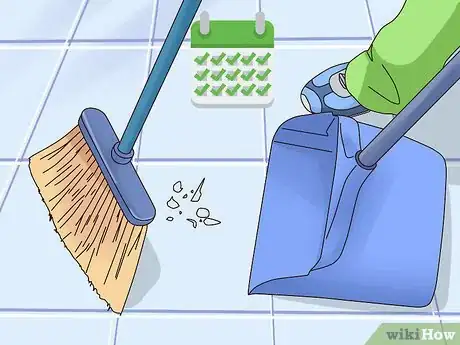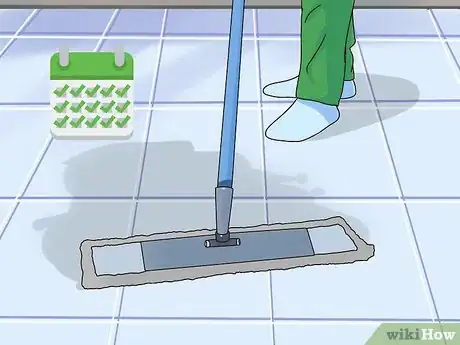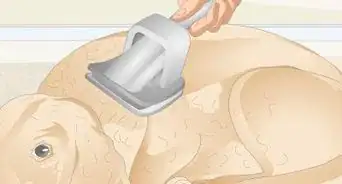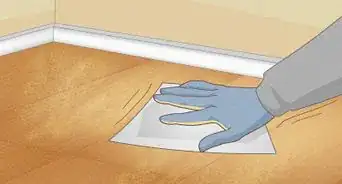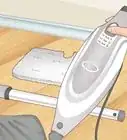This article was co-authored by Michelle Driscoll, MPH. Michelle Driscoll is the Owner of Mulberry Maids, which is based in Fort Collins, Colorado. With five years of experience, her business specializes in cleaning homes and small offices. She holds a Masters in Public Health from the Colorado School of Public Health. Additionally, Mulberry Maids has an A+ rating from the Better Business Bureau.
There are 9 references cited in this article, which can be found at the bottom of the page.
This article has been viewed 39,491 times.
A well-polished tile floor can make a room feel clean and inviting. Whether you have ceramic, vinyl, stone, or any other type of tile flooring, giving your tile a shiny luster doesn't have to be difficult, time-consuming, or costly. The keys to a polished tile floor are a clean and well-buffed surface and regular maintenance.
Steps
Using Commercial Polishing Products
-
1Remove any obstacles that may get in the way. The first thing you should do is remove any furniture or obstacles that may obstruct your ability to clean your floor. This includes tables and chairs, but also placemats and rugs. You don't want to have to stop in the middle of the process to slide furniture out of the way.[1]
- This also includes the family pets! You may want to consider keeping the door closed, using a baby gate, or blocking off the entrance to the room with a chair or something that would prevent any four-legged friends from getting in.
-
2Sweep the floors to remove large dirt particles. After clearing the room, take a broom and sweep up any dust and dirt that may have built up on the tile floor. If you plan to apply wax later, a dirty floor will make it difficult to adhere, and make the floor look grimy. You also don't want to just move dirt around as you polish, so it's best to thoroughly sweep the floor first.[2]
- Be sure to get into the nooks and crannies and remove as much dirt as you can.
- You could also use a dry mop, also called a dust mop, to sweep the floor. Dry mops are great for picking up dirt and dust without leaving streaks.
Advertisement -
3Scrub the grout in between the tiles with a soap and water and a scrub brush. Before you mop the entire floor, take a stiff brush and focus on cleaning the grout in between the tiles. Grout requires a little more effort to scrub clean, so you may need to get down on your hands and knees to scrub it well. Discolored or dirty grout will really stand out once your tile floor is polished.[3]
- For really stubborn grout, you can use a toothbrush to scrub it. For stains or darkened grout, sprinkle baking soda over the grout, then spray white vinegar over it. Let the baking soda and vinegar sit for 5 minutes, then scrub the grout with your toothbrush.
-
4Mop the floor with warm water and 1 to 2 drops of dish soap. A little bit of dishwashing soap goes a long way. One to two drops is plenty for 1 gallon (3.8 L) of warm water. Dip your mop into the bucket and slosh it around a bit to get the water nice and sudsy. Then wring the mop into the bucket to remove any excess water. Start at one part of the room and work your way across the entire floor, mopping in big sweeping motions.[4]
- It's best to use as little soap as possible when cleaning your tile because excess soap can leave a residue on the tile.
- Make sure the bucket is large enough to hold 1 gallon (3.8 L) of water without sloshing over the sides.
- The bucket itself should be clean to start with as well. You don't want to start by adding more dirt to your soapy water!
- When you are finished mopping, clean your mop by rinsing with clean water so that it doesn't harden and build up dirt.
-
5Allow the tile floor to fully dry. When you have finished mopping the floor, empty the bucket and rinse out any residue to give your floor some time to dry. It's very important to let your tile dry completely before you do anything else to it. Wet tile will make it difficult to add any cleaning solutions or to buff the tile.[5]
- Wait at least 1 hour to let your floor dry.
- You can use a fan in the room to help your floor dry quicker.
-
6Apply a wax stripping solution to remove any built up wax. If your tile floor has previously been waxed, you'll want to remove it before polishing. The old wax may be flaking or collecting dirt, and will affect the overall polish. Fill your bucket with a wax stripper and scrub your tile floor clean of any old wax with a scrub brush, then mop the floor with clean water to remove any chemical residue.[6] Allow the floor to dry at least 1 hour before moving on, but make sure the floor is fully dry.
- You can find wax stripper at any home improvement or hardware store.
-
7Try hydrochloric acid for soap scum and water deposits on tile flooring. Hard water deposits and soap scum stains require heavy duty chemicals to be removed. Empty the bucket of water completely, then fill it with 4 cups (950 mL) of water and 1⁄2 cup (120 mL) of hydrochloric acid. Apply the mixture directly to the stain and allow it to sit for several minutes. Then scrub the stain clean and allow the area to dry completely.[7]
- Hydrochloric acid is available for purchase at most hardware stores. It is also often sold at pool supply stores because the acid is commonly used to sanitize swimming pools.
- Hydrochloric acid is a harsh chemical and can burn your eyes and throat, so mix it in the bucket outside or a well-ventilated area.
- Be sure not to get any of the chemical on your skin as it can cause chemical burns.
-
8Use an electric floor buffer to buff the tile floor quickly. A floor buffer is a great option for a quick and consistent buffing. Consider renting or borrowing one for the day if you do not own one. They are often as easy to use as a standard vacuum cleaner. Turn the buffer on and move it across the tile floor using small, sweeping side-to-side movements for an even finish.
- You can rent electric floor buffers from home improvement stores like Home Depot for around $30 a day.[8]
Using Natural Products on Tile Flooring
-
1Clear the tile floor of furniture and obstructions. Before you start, be sure to move any furniture that can get in the way of polishing your tile floor. Remove chairs and tables as well as rugs and mats that may be in the way. If you have tile you'd like to polish that is underneath or adjacent to appliances, you'll need to remove them as well.[9]
- Use a baby gate or close the door to the room to keep out any pets that could walk over the tile floor while you're cleaning it.
- If you have tile flooring underneath cabinets or in a pantry or closet, make sure you clear out anything that could get in the way of cleaning and polishing.
-
2Mix 1 gallon (3.8 L) of warm water and 1⁄4 cup (59 mL) of white vinegar. Vinegar is an age old cleaning product that is much less harsh on the environment than industrial cleaning chemicals. Vinegar is also safe to use on tile and will not stain or discolor your tile flooring. Fill your bucket with warm water because warm water will help the vinegar mix and form a natural cleaning solution.[10]
- Use this vinegar solution to scrub, mop, or clean your tile floor.
-
3Sweep the tile floor to remove dirt and dust on the surface. Once the room is clear of obstructions, use a broom to sweep the floor free of large dirt particles to make it easier to polish. Mopping a dirty floor can just move the dirt around and make your tile look dingy. A good sweep before you mop is always a good idea for a clean floor.[11]
- Don't neglect sweeping the corners of the room or beneath any cabinets.
- A Swiffer or dry mop works great to pick up dirt.
-
4Scrub the grout between the tile with a stiff brush or toothbrush. Focus on the grout in-between the tiles before you clean the whole floor. Dirty and discolored grout will stand out once you've finished polishing the tile, so it's best to clean it well before you clean the rest of the floor. You may need to put in a little elbow grease and get down on your knees to scrub the grout well.[12]
- Treat very dirty grout before you start scrubbing. Sprinkle baking soda over the grout, then spray vinegar onto it. Leave it to sit for 5 minutes before you start scrubbing.
- If you have a lot of grout, it's best to use a grout brush because it will be more efficient than a toothbrush. You can buy a grout brush for a few dollars at most department stores or online.
- Don't scrub the grout so hard that it starts to flake or chip off!
-
5Use a mop to clean the whole tile floor. It's important that you clean the tile floor well before you begin to polish it. Because you're not using chemical soap, you don't need to mix or slosh the water to create suds. Dip your mop into the vinegar solution, wring out any excess water, and mop the floor in broad strokes. Work your way from one end of the room to the other, taking care not to miss any spots on the tile floor.[13]
- Don't forget any corners, cabinets or pantries.
-
6Apply club soda to remove any built up floor wax. Club soda is an excellent natural and environmentally-friendly wax-stripping alternative. Fill a clean bucket with only club soda and scrub your tile with a brush to remove old wax. Then use clean water to mop up any residue and allow the tile floor to fully dry.[14]
- For a stubborn wax buildup, you can let the club soda sit for a few minutes before you scrub it.
-
7Buff the tile floor with a microfiber cloth. Buffing your tile floor can really bring out its shine and add a smooth texture to the finish. Use a microfiber cloth and buff the floor in smooth, even circular motions. Start at one end of the room and work your way across so you don't miss any sections.[15]
- Some dry mops have microfiber pad attachments you can use as well.
Maintaining the Tile Floor
-
1Vacuum or sweep your tile floor every day. The best way to maintain your tile floor's polish and shine is to keep it clean. Sweeping and vacuuming will remove dirt and debris that can build up and cause your tile to lose its luster. Even worse, dirt that is left for a long time can get smashed into the tile and turn into grimy stains.[16]
- If you plan to mop, make sure you sweep or vacuum first.
-
2Mop the floor regularly. In addition to sweeping or vacuuming dirt and debris, it's important to mop your tile floor to maintain its polish. This doesn't necessarily mean dragging the bucket and soap out every other day. If your floor doesn't require a heavy cleaning, a damp mop will be enough to keep it clean.[17]
- Keep your mop clean so you're not spreading dirt around your tile floors when you mop.
- You can also use dry mops like a Swiffer for an easy clean.
-
3Clean any spills or stains quickly. To keep your tile floor polished and without any deep stains, it's important that you clean up any spills that occur as soon as possible. Things happen, stuff spills, but the longer a spill sits, the more it can stain and soak into your tile and grout. They can also cause your floor to be sticky, which can attract dust and dirt to adhere to your tile.[18]
- Use disinfectant if necessary, but sparingly, as the chemicals can discolor tile flooring.
Things You'll Need
- Broom
- Mop
- Bucket
- Scrub brush or toothbrush
- Dishwashing soap or vinegar
- Wax stripper or club soda
- Microfiber cloth or electric floor buffer
References
- ↑ https://www.bobvila.com/articles/waxing-hardwood-floors/
- ↑ https://www.bhg.com/homekeeping/house-cleaning/tips/how-to-clean-tile-floors/
- ↑ http://www.housecleaningcentral.com/en/cleaning-tips/floors/cleaning-tile-floors.html
- ↑ https://www.mrright.in/ideas/home-improvement/polish-ceramic-tiles/
- ↑ https://cleaning.tips.net/T006446_Polishing_Ceramic_Tiles.html
- ↑ https://www.thriftyfun.com/Removing-Wax-Buildup-on-Floors.html
- ↑ https://www.todayshomeowner.com/video/how-to-clean-tile-with-muriatic-acid/
- ↑ https://www.bobvila.com/articles/waxing-hardwood-floors/
- ↑ https://www.bobvila.com/articles/waxing-hardwood-floors/
- ↑ https://www.mrright.in/ideas/home-improvement/polish-ceramic-tiles/
- ↑ https://www.bhg.com/homekeeping/house-cleaning/tips/how-to-clean-tile-floors/
- ↑ http://www.housecleaningcentral.com/en/cleaning-tips/floors/cleaning-tile-floors.html
- ↑ https://www.mrright.in/ideas/home-improvement/polish-ceramic-tiles/
- ↑ https://www.mrright.in/ideas/home-improvement/polish-ceramic-tiles/
- ↑ https://www.bobvila.com/articles/how-to-clean-porcelain-tile/
- ↑ https://www.bhg.com/homekeeping/house-cleaning/tips/how-to-clean-tile-floors/
- ↑ https://www.bhg.com/homekeeping/house-cleaning/tips/how-to-clean-tile-floors/
- ↑ https://floorcritics.com/how-to-clean-tile-floors/
